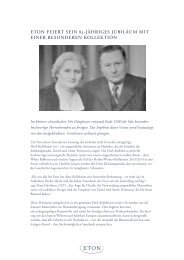Formal wear origins
Formal wear origins
Formal wear origins
You also want an ePaper? Increase the reach of your titles
YUMPU automatically turns print PDFs into web optimized ePapers that Google loves.
SPECIAL FEATURE<br />
FORMAL<br />
WEAR<br />
FORMAL WEAR CULTURES<br />
FORMAL WEAR AS<br />
A CULTURAL HERITAGE<br />
— 43 —<br />
BACK IN THE DAY<br />
FORMAL WEAR ORIGINS<br />
— 46 —<br />
THE BESPOKE COACH<br />
BLACK OR WHITE TIE?<br />
STICK TO ETIQUETTE,<br />
GENTLEMEN<br />
— 48 —<br />
AUTUMN-WINTER<br />
2011-2012 ACCESSORIES<br />
— 54 —<br />
SCABAL ACROSS THE WORLD<br />
AN ENGLISHMAN IN NEW YORK<br />
— 56 —<br />
STYLE TRIBUTE<br />
GARY COOPER: THE DEMOCRATIC PRINCE<br />
— 59 —<br />
INTERNATIONAL AGENDA<br />
FOLLOW THE DRESS CODE<br />
— 62 —<br />
FORMAL WEAR CULTURES<br />
FORMAL WEAR AS A<br />
CULTURAL HERITAGE<br />
In our European and North American countries, we all know the traditional white tie and<br />
black tie. But world is wide. Let’s cross the borders and meet particular formal outfits that<br />
reflects local heritages.<br />
Some of them are<br />
very well-known<br />
as the Scottish kilt<br />
and the Japanese<br />
kimono. Other<br />
are less popular<br />
outside their native<br />
country. In all<br />
the cases, their precise <strong>origins</strong> and<br />
the way the are still worn today stay<br />
generally neglected. Follow the guide<br />
and do not hesitate to keep your black<br />
tuxedo home when you visit one of<br />
these countries for a formal event.<br />
THE SCOTTISH KILT<br />
That most Scottish of garments, the<br />
kilt, was developed by an Englishman,<br />
Thomas Rawlinson. In 1727 he set up<br />
an iron-smelting furnace in the north<br />
of Scotland with the help of a local<br />
regimental tailor he shortened and<br />
simplified the long plaid cloth that<br />
the local workers wore around their<br />
bodies. In the 19 th century English<br />
landowners in Scotland adoptedthe<br />
outfitin a romantic way, but despite<br />
national rivalries Scots all over the<br />
world proudly <strong>wear</strong> it as their national<br />
dress. Some <strong>wear</strong> the kilt as regular<br />
day attire, but more commonly it is<br />
worn as formal dress for weddings,<br />
evening dinners and celebrations.<br />
The pleated skirt, fastened on<br />
the waist with side adjusters, just<br />
hits the knees. The classic formal<br />
accompaniment is a short,singlebreasted,<br />
black jacket, a neat<br />
waistcoat, white shirt, black bow tie,<br />
and a sporran, the wallet slung from<br />
a chain at the front of the kilt. Heavy<br />
brogues, thick socks and a skean dhu<br />
(a decorative knife) down the sock<br />
complete thetraditional Highland<br />
outfit. Growing in popularity as an<br />
alternative to the kilt today are trews,<br />
tightmilitary-style trousers without an<br />
outside seam. Whether kilt or trews,<br />
the cloth must be tartan, of course.<br />
The Scottish kilt<br />
BESPOKEN I 43



